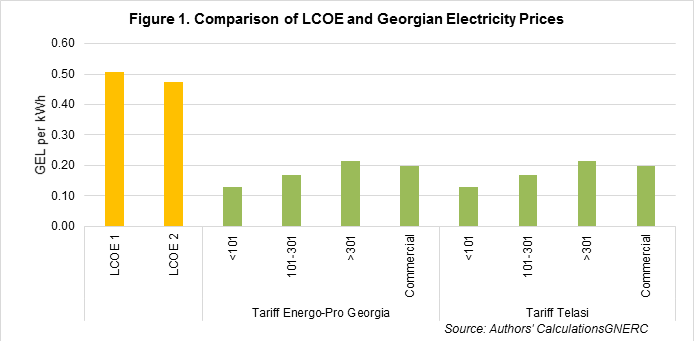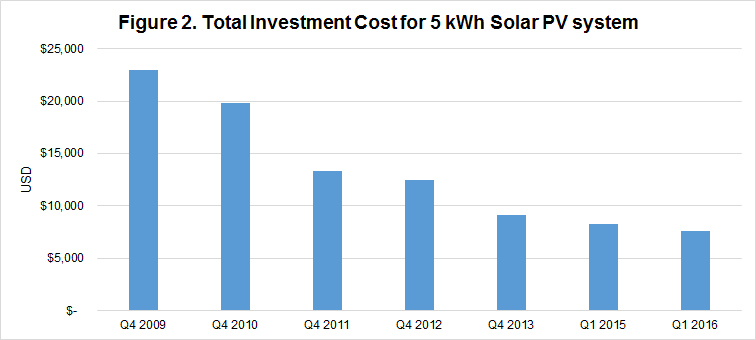 31
May
2023
31
May
2023
ISET Economist Blog
 Saturday,
19
November,
2016
Saturday,
19
November,
2016

 Saturday,
19
November,
2016
Saturday,
19
November,
2016
"We have this handy fusion reactor called the SUN. You don't have to do anything, it just works, shows up every day, produces ridiculous amounts of power." Elon Musk Introduction of Tesla Energy
A few weeks ago Elon Musk (CEO of SpaceX and Tesla Motors and Chairman of SolarCity, among others) presented two new products: solar roof tiles produced by SolarCity, and Tesla’s Powerwall 2, designed to work together to revolutionize the concept of solar PV systems. Energy sector professionals, environmentalists, and renewable energy enthusiasts around the world (including Georgia) were thrilled, and started sharing information and opinions about the new products on social networks, talking of another step towards the revolution of the power sector so many are waiting for.
Almost in parallel with Mr. Musk’s presentation, the Georgian Energy and Water Supply Regulatory Commission (GNERC) introduced a new regulation on net metering, which makes it possible for households with solar panels to supply electricity to the power system and get compensated when the amount supplied exceeds that taken from the system. This is a well-known policy solution utilized in Europe and in the U.S. to support (and stimulate) the expansion of small-scale renewable power generation. The principle of net metering in the new Georgian regulation is very simple: the owner of photovoltaic panels can supply excess electricity to the system, and purchase power from the system when solar is not providing sufficient electricity to cover the owner’s consumption needs. In cases when the monthly balance (electricity produced minus electricity consumed) is negative, the household pays for the net amount of electricity consumed. In the opposite case, when the monthly balance is positive, the household accumulates an electricity surplus. This surplus can be used to offset negative balances in the following months. If the yearly balance remains positive, the customer can ask to be compensated. Because Georgia does not have any feed-in tariff policy for small-scale renewable power generators (i.e. installed capacity below 100 KW), the household will be paid the weighted average wholesale tariff set by GNERC for power distribution companies, which is below the consumption tariff.
The profitability of small photovoltaic (PV) systems depends on many aspects such as: the characteristics of solar radiation and the outside temperature in a given location, the investment costs associated with the installation of the system, the electricity tariff paid, and how well the system is engineered and installed. The profitability of a system can be assessed using several methods. One of these is the Levelized Cost of electricity generation (LCOE), i.e. the average cost per kWh of the electricity generated by the system over its lifetime. If LCOE is lower than the tariff the household pays for the electricity, it would be potentially profitable to invest in a solar system.
Let’s do some calculations to see how profitable a PV system would be in Georgia, given today’s market conditions. Let’s take, for example, the case of a house in Tbilisi with a PV system with an installed capacity of 5 kW on its roof. The latest market analysis of PV systems shows that the cost of a fully operational system with these characteristics will be around USD 7,600 (18,885 GEL). Under the Tbilisi conditions of annual solar radiation (i.e. Global Horizontal Irradiance) of 1,300 kWh/m2, this system – if engineered and installed properly – can be expected to generate between 4,575 (scenario 1) and 5,200 (scenario 2) kWh of electricity annually over next 20 years. Given these numbers, we estimated an LCOE between 20-19¢ (51 and 47 tetri respectively) per kWh, more than twice larger than the current fixed tariff for the system (Figure 1).

Judging from our results, investing in PV generation would not seem to make a lot of sense. Who would want to produce and consume electricity at a cost so much higher than the official tariff? At this stage, indeed, investing in solar PV makes sense (from a purely financial point of view) only in very special conditions. For example, as mentioned in a previous blog post (Access to Electricity: Is Off-the-Grid an Option?), solar PV constitutes an interesting alternative when access to the grid is absent or connecting to the grid is particularly costly.
The current lack of competitiveness of solar PV for electricity generation at the residential level is not just a Georgian peculiarity. This is why countries around the world aiming at increasing the share of renewables in their energy balances have used a multitude of mechanisms to support their development. Countries such as Austria, France, Germany, and Italy, for example, have supported solar generation with subsidized loans, feed-in tariffs (setting relatively high purchasing prices for energy coming from solar PV), and other specific subsidies and tax breaks.
Does this mean that also Georgia should actively support solar PV generation? Not necessarily. As we have seen, from the financial point of view, investing in solar PV generation is still quite costly. Would the potential economic gains from expanding solar generation be high enough to more than compensate these financial costs? It is doubtful. If this is the case, a country like Georgia, characterized by large investment needs and limited resources, would do better to wait until better times come.
Our calculations make it clear that the immediate future of Solar PV in Georgia is not going to be bright, in the absence of additional support mechanisms lowering the costs or increasing the benefits of investing in Solar PV. Therefore, it will take some time before the regulation about net metering becomes relevant.
Still, its introduction marks a very important moment for the Georgian electricity market. Technological progress is proceeding very quickly, especially in the energy sector. Elon Musk’s announcement is just one of the many signs that a true revolution in the way we generate, store and utilize energy is taking place. As the costs associated with solar panels and batteries go down, the structure of our power systems and our economies will change, and with it will change our way of life.
Figure 2 shows that the total cost for 5kW installed capacity of the Solar PV system fell by more than 2/3 (in dollar terms) in the last 7 years. If the cost continues to fall at this speed, one can expect that in a few years, Georgian families will be able to save (and maybe even make) money thanks to their investments in Solar PV.

Those families will then appreciate the far-sightedness of the Georgian regulator, which has laid today the foundation for the success of the power revolution of tomorrow.





